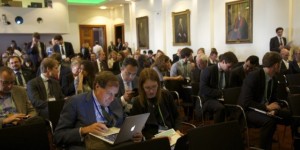By Leona Liu, originally published at Forests News
 Private sector investment in landscapes is no passing fad. It’s here to stay. That was the driving consensus among the 300+ participants of the Global Landscapes Forum: The Investment Case, which took place at the Royal Society of London on June 6. The Global Landscapes Forum is a key event under the CGIAR Research Program on Forests, Trees and Agroforestry (FTA).
Private sector investment in landscapes is no passing fad. It’s here to stay. That was the driving consensus among the 300+ participants of the Global Landscapes Forum: The Investment Case, which took place at the Royal Society of London on June 6. The Global Landscapes Forum is a key event under the CGIAR Research Program on Forests, Trees and Agroforestry (FTA).
“We’ve all noticed a very important paradigm shift in how the private sector has been contributing to concrete tangible solutions for climate change challenges all over the world,” said Forum attendee Ayman Cherkaoui, the UNFCCC COP 22 Adviser to the Environment Minister of Morocco.
“The future is synonymous with landscapes,” said Mark Burrows, Managing Director and Vice Chairman of Global Investment Banking at Credit Suisse. “This is going to be a five to seven-trillion dollar investment space within the next 10-15 years. Every bank and every institutional investor is now turning their attention to this space. The biggest problem today is not the weight of money. The capital is there. The main problem we’re dealing with now is: ‘How do we get this large bulk of money to trickle down to those who need it the most- the smallholders?’”

Indeed, a ‘landscape approach’ is largely about working across traditional institutional boundaries, which can hinder the integration needed to achieve progress. Among the biggest boundaries that exist today in relation to landscape approaches is the one between the private finance sector and the land-based sectors- hence the need for such an event.
Given their diverse institutions, expertise and terminologies, the public and private sectors need to come together to find a common language in order to develop innovative solutions. The current climate and development frameworks provide a strong rationale and momentum for this to happen.
Post-Paris, private sector engagement is needed more than ever
In 2015, three major policy outcomes reinforced the need for the private sector to step up to the plate: the UN’s Third International Conference on Financing for Development in Addis Ababa, Ethiopia, the signing of the Sustainable Development Goals (SDGs), and the adoption of the Paris Agreement.

Delivering on the promise of the Paris Agreement and the SDGs will not only require strong political commitment, but substantive capital. At the COP 21, more than 180 countries submitted their Nationally Determined Contributions (NDCs) pledges to the UNFCCC. According to these plans, $16.5 trillion is needed over the next 15 years to finance climate action. The public sector alone cannot meet this need.
“It set out a particularly important role for the private sector and multilateral development banks (MDBs) to play. MDBs – being the largest financiers- are essential to catalyze the large sums of money needed to get us to the $100 billion. As a donor government, it’s important that we start thinking about how we use our public financing to mobilize these much larger flows that are coming through the private sector and MDBs.”
The Green Climate Fund (GCS)– established in 2010- is gearing up as the main vehicle for achieving the climate change objectives as defined at the COP 21. The Fund invests in low-emission and climate-resilient development. It is the only stand-alone multilateral financing entity that aims to deliver equal amounts of funding to mitigation and adaptation. This is extremely significant given the present parity between the two.
The attention to equalizing private sector investment in mitigation and adaption is also a key priority for the COP 22 that will take place in Marrakech, Morocco this November.
“When it comes to private investment on the mitigation side, it’s becoming stronger and stronger with each passing day. We are seeing record levels of investment all over the world,” said Cherkaoui. “But at the same time, the investment case for the adaptation side needs to be strengthened. We are now seeking all types of inputs on how to do that.”











